Buenos Aires – Back in the summer of 1980 I participated in the first really organized gay pride march in Ann Arbor, Michigan, my hometown. Maybe 100-125 of us, maximum, gathered on the steps of the federal building. Speeches were speechified, chants were chanted, marching commenced. We walked along the couple of commercial streets in the center of town, wandered through the adjacent residential neighborhood, and then onto the University of Michigan campus. We chanted, sang, laughed, and talked with friends along the way. We watched for television cameras and photographers, hoping that nobody would film us and broadcast it, outing us to the world faster than we were ready for. We had no floats, just us marching, carrying signs with a variety of gay rights slogans. There weren’t really many onlookers, and the supporters we encountered jumped into the march. There were no real anti-gay protests that we ran into, it was a relatively smooth, painless process that was over in an hour or two, after which we broke off into groups of friends to go celebrate the experience.
For the last twenty-some years I’ve lived in New York City, and that’s been a whole different experience. Tens of thousands of marchers, and equal or more numbers of onlookers line a parade route that stretches from Central Park to Greenwich Village and takes hours to complete. Professionally designed floats, music and sound systems, parade marshalls and a strong police presence are the order of the day. Political groups abound, often having little or nothing to do with gay pride. Organized parties, dances, and a street fair compete for the after-march experience. It’s all quite big business feeling – for me, it has no soul, and hasn’t for many years – I used to march with one group or another, then later became an onlooker, and the last few years, have just not bothered.
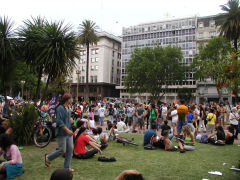
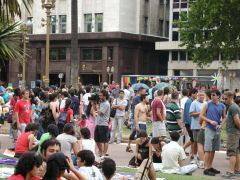
Yesterday evening was Buenos Aires’ 14th annual gay pride march. It was originally scheduled a few weeks ago, but turned out to be the same weekend as the big “all Americas” presidential conference that got so much press. Rather than forcing folks to choose between the march and joining in with protests over that, it was decided to reschedule the march. A couple thousand folks gathered in the mid to late afternoon in the Plaza de Mayo, outside the Casa Rosada (Pink House), which is the presidential office building. Most of the few hours prior to the march were taken up with various speechifying, a bit of chanting, and lots of music. Friends gathered on the plaza, people saw people they hadn’t seen all year, buttons and t-shirts were sold, but it was all very laid back.
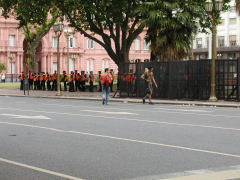
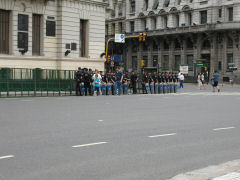
There was something exhilarating in the somewhat trepidatious approach to it all – even after 14 years, a few folks attending had their faces covered to obscure their identity. Of course, up until a couple of years ago there was a real fear of arrest or persecution here, just for participating. There was a police presence, yes, but really nothing more than what is typical around the presidential building when there’s any kind of protest rally or march (there was an additional contingent outside the McDonald’s that was fire-bombed during the presidential conference – it’s been repaired and reopened – but their was an obvious concern over a repeat). Anti-gay protestors, who were few in number, were kept at bay by the police, outside the square’s main church, and at a bit of a distance from the march. At one point someone screamed out something about getting out of the way, the cry was taken up, and there was a momentary panic as maybe a hundred folk started stampeding away from what they thought was some sort of serious problem. It turned out to be the unfolding of the giant pride flag and just a need for space, and in a minute or so calm was restored.
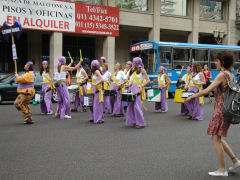
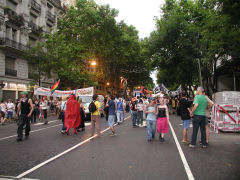
Scheduled for 6:00, the march actually stepped off around 6:30. There were no professional floats – a few flatbed trucks were in use to bring along the equivalent – but no fancy designs. Lots of folks carrying flags and signs with slogans. As we marched down the dozen blocks of Avenida de Mayo to Plaza de los 2 Congresos, and the building housing the congressional offices, there were maybe a few hundreds of onlookers, who, for the most part, jumped into the swirling mass of disorganized but exhuberant humanity. There was a light drizzle just after the start, which ended in a triumphant mass cheering as the clouds broke and a rainbow appeared over Avenida 9 de Julio. There was one small political contingent in the middle of the parade – protesting against George Bush. Interestingly nothing against the local government. He’s really not liked very much here. A group of maybe two dozen members of the communist party trailed along a good block behind the march. That was about it for the politics.
A half dozen American (U.S.) gay men in their mid to late-20s were standing nearby – one of them commented that the whole thing seemed like “Gay Pride 101” and wasn’t worth having come to Buenos Aires for. They headed off to parts unknown. They missed the point. I have no doubt that at their age they also missed the era when it took courage to participate – it wasn’t about floats and dances and bars.
The parade part was all over in not much over an hour. There was another rally and lots of music on the steps of the Congreso building that went on for hours. For the most part, folks broke off into groups of friends to head off and celebrate. It had that feeling of 1980 all over again. I’ve missed that.
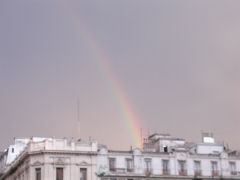
A friend of mine sent me an e-mail about this post, to which I responded, that maybe fleshes out my feelings about things “here” and “there” a bit. I’ll reproduce the exchange, slightly edited for relevance.
He wrote:
Enjoyable indeed, and an interesting experience/perspective. I will say that for my part, I went to the NY parade with my boyfriend for a few years, then grew tired of it for the same reasons you cite. But then I heard Harvey Fierstein speaking on “In the Life” sometime last year. He basically said (in reference to the political situation, and acceptance overall): if you’re not out there marching, if you’re not out there being counted and working to make a difference, you have no business complaining about the state of the nation. This year, I marched for the first time, and my boyfriend was there at my side. We went with the Pride Agenda. He held a big blue balloon that said “Equal Rights: No More, No Less”, and I handed out upwards of 2,000 stickers with the same message. It was an obscenely hot & sunny day, but we made it for the full 5 hours it took to reach the piers, and I think we’ll probably do it again next year.
So I guess my point is, I think the NYC parade can still have soul to balance any cheesy floats, if we make our own presences seen, heard and felt — not as strippers, drag queens or other fantasies, but as we truly are every day.
My response:
While I do understand Harvey’s point (and I heard it as well), I don’t necessarily agree. The biggest difference between NYC and BsAs is that in New York there are opportunities to stand up and be counted on a daily basis. There are organizations, clubs, events, political groups, social groups, rallies, and a whole bevy of other things. And I’d certainly agree with Harvey that if you’re not active in some fashion, out there being counted, then he’s right, you have no right to complain. I think a lot of what’s made the parade into what it has become is that it is, at least in my view, a distant second to all that – what has become important in New York is being out in daily life, and in other visible activities.
That’s still not possible here – theoretically yes, after all this country has had legal civil unions for gays for more than a decade – in practice, not so much, it’s still a very closeted country – the openly gay part of Buenos Aires (and it’s really limited to just the city, not the country as a whole) is very much a tourist thing, not the residents. The parade is a once a year chance for locals to really and truly come out of the closet in a supportive event, a chance to have something about being gay actually appear on the news, a chance to see that they aren’t alone, a chance for that person who snuck out of the house because maybe, just maybe… can be touched, can be swept along in the parade, and join in for a little while.
And while I could buy the argument about a need for the balance of those of us who are just ourselves versus the strippers and floats, the question becomes, for whom? The people lining the parade route are more of the same, the people who the parade, in my view, used to be for, to reach out to, aren’t there. And if they are, I don’t really think they see the balance, I think they just see the flash. And what appears on the news media to maybe reach someone who didn’t get out of the house to get there, or maybe to change someone’s point of view? Only the stuff that just reinforces the stereotypes.
Who knows? Maybe I’m just jaded about New York in general, I have to admit, I sure don’t miss it!
[…] Stretching from the National Congress building to the Presidential Palace is the famed Avenida de Mayo, the city’s official processional route. I’ve travelled it by bus and taxi, purely by happenstance, and even walked the length once during the gay pride parade, though my attention wasn’t on the architecture that time. Back during the late 19th and early 20th Centuries, this was one of the main avenues to be completely rebuilt in a style that was intended to imitate the capitols of Europe, and especially Paris. Most of the buildings built at that time are still standing, and are a tribute to the French Beaux Arts architectural style. […]